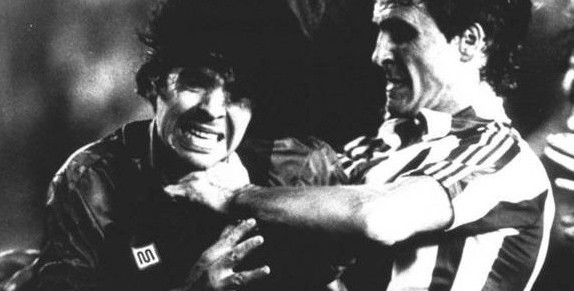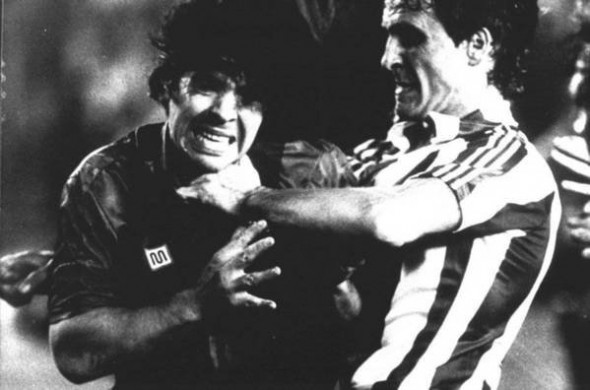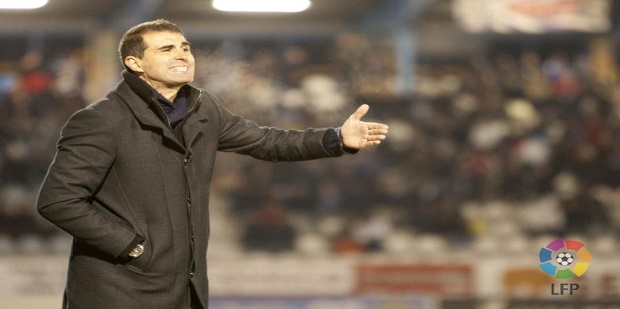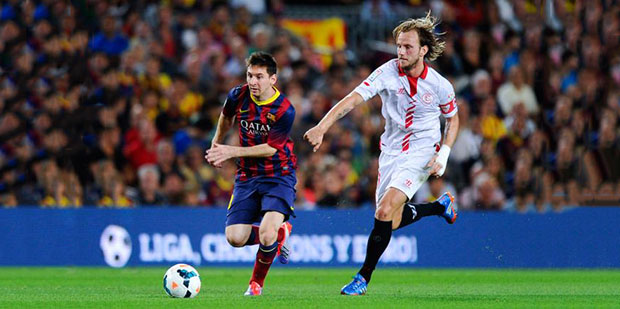- S.D. Eibar ready for maiden La Liga outing
- SD Eibar stengthen ahead of debut La Liga season
- Can ‘Super Mario’ live up to expectations in Madrid?
- MAN IN THE GROUND – Brentford 0 – 4 Osasuna
- Historic Basque derby welcomes S.D. Eibar to La Liga
- Munich to Madrid, via Brazil – Tony Kroos
- Rakitic in Spanish Switch
- Can Spain find redemption in Rio?
- Viva Espana! A season of redemption for Spanish football
- From the old to the new: who can fill the void in years to come for La Roja?
When the nastiest rivalry in Spain was between Barcelona and Athletic
- By Scott Oliver
- Updated: 29 March, 2012


This is an exclusive extract offered to El Centrocampista by the collective of writers at The Blizzard. To read the full article buy Issue Four of The Blizzard which is out now on a pay-what-you-like basis in digital and hard copy format. Find out more here.
THE OTHER RIVAL, ANOTHER WAY: WHEN THE NASTIEST RIVALRY IN SPAIN WAS BETWEEN BARCELONA AND ATHLETIC
By Scott Oliver
There are some rivalries — those ferocious cross-town antagonisms of Istanbul and Cairo, say, Athens and Rome, Belgrade and Tehran, or the multifarious, volatile Latin American clásicos and superclásicos — that are hewn for the ages, it would seem: a self-perpetuating, endlessly renovated symbiotic loathing in which each new supporter is compelled, as a kind of initiatory sine qua non, to adopt a bone-deep, acid-sweat hatred of the Other Lot. Now, while a modicum of intellectual modesty and smidgeon of philosophical rigour ought to preclude us from asserting with absolute certainty that these tête-à-têtes are, despite appearances, fixed and eternal (yes, even the Auld Firm), the fact that they rumble forward at glacial speed — nourished by an animosity so viscous and seemingly implacable that fans on both sides of the divide never escape the gravitational pull of their compulsory mutual abhorrence — indeed creates the sense of a de facto permanence from which the supporters henceforth appear to derive their rigid identity. I might not always be sure of what I’m for, exactly (because beneath the Holy Shirt we seem ever to mutate), but I know damn well what I’m against…
Then there are others, lacking the fetid cheek-by-jowl antipathy of the metropolitan derbies, going by way of personalities rather than institutions and thus less durable, but that nevertheless attain, for a period, an intensity every bit as vehement and consumptive as those seemingly primordial antagonisms before then ebbing away. In West Germany in the late 1960s and early 1970s, for instance, Borussia Mönchengladbach and Bayern Munich were fervid adversaries despite possessing between them most of the national team, while the same period in England saw bloodshed every time the Chelsea of ‘Chopper’ Harris locked horns with Don Revie’s notoriously nefarious Leeds team.
Indeed, the 1970 FA Cup final replay, watched by an incredible 28 million people, the second highest figure ever in the UK for a sports broadcast (eclipsed by the 1966 final alone), was arguably the most savage football match seen on these shores. When reviewed by David Elleray in 1995 through the lens of contemporary refereeing standards, he concluded that Leeds would have incurred seven bookings and three dismissals (Johnny Giles, Billy Bremner and Jack Charlton), while Chelsea deserved thirteen yellows, including three each for Harris, Dave Webb, and Charlie Cooke. As it was, so lenient was Eric Jennings, in his swansong as a referee, that only Chelsea’s Ian Hutchinson saw yellow.
A similarly foul and fierce yet ultimately temporary rivalry emerged during the early 1980s in Spain — that heterogeneous nation of somewhat precarious unity and internecine squabbles (always, until recently, offered as the fundamental cause of their failings in tournament football, of course) in which the extraordinarily tenacious cultural and historical roots of Barcelona’s face-offs with Real Madrid have of course engendered the mightiest oak of a feud (one whose acrimony seems to have been ratcheted up still further by José Mourinho’s pantomime villain shtick and the fact that there are no other serious top-dog candidates, the twin titans’ financial power creating a positive feedback loop continually reinforcing their hegemonic duopoly). However, despite the Barça-Real antipathy, for a short time an enmity every bit as spiteful settled between two of the country’s most potent institutional symbols of regionalism, both beacons of the autonomous regional identities emerging groggily from under the jackboots of Falangist Spain after Franco’s death in 1975.
In the blaugrana corner, there was the Catalanism embodied by FC Barcelona (self-avowedly més que un club), which tended to express itself and any hankerings for independence through comparatively moderate and mature assertions of its economic power and cultural advancement, the extrovert city of Barcelona long having prided itself on being the habitual sluice through which vanguard artistic, philosophical and scientific currents arrived from elsewhere in Europe. In the rojiblanco corner stood the standard bearers of Basque identity, Athletic of Bilbao, the only club aside from Barça and Real never to have been relegated from the Spanish top flight, a club whose reserves, Bilbao Athletic, often pull 10,000 spectators from a city that Phil Ball says “smells of football” — a throbbing industrial Glasgow to Barcelona’s well-heeled, sophisticated Edinburgh.
Given that early-eighties Spain was still at the dawn of its tentative transition to democracy, one could be forgiven for assuming that Franco’s assault on indigenous Catalan and Basque culture might have united these two clubs against the ‘imperial’ Real Madrid, occasional propaganda tool of the ultra-centralist Generalísimo (who of course invited the Luftwaffe’s Condor Legion to bombard the symbolic cradle of Basque culture, Gernika, on 26 April 1937). However, for a short time their rivalry — fructified as much by specific personalities involved as by geography or history — really did surpass in fervour el clásico’s historically sedimented enmity. And at the heart of it all were two men more than familiar to students of the sport’s annals of infamy…
….
Although the club has distinctly British roots — a fact borne out by its name (Athletic not Atlético although Franco did insist on the Spanish orthography, as indeed Barça were obliged to call themselves CF Barcelona, rather than FC) — it has nevertheless fielded an all-Basque team since 1912, which remains the case to this day (the current central defender Fernando Amorebieta plays for Venezuela, the country of his birth, but was raised in the Basque Country, where he has lived since he was two years old, while both of his parents are Basques, too, who simply happened to be working in Venezuela in the mid-eighties). So, this year marks a centenary without any Spaniards, let alone ‘proper’ foreigners in the Athletic ranks, unlike their neighbours from San Sebastián, Real Sociedad, who relaxed this rule in 1989 with the arrival of John Aldridge and then in 2001, signed a first non-Basque Spaniard when Boris joined from Real Oviedo.
The whole question of the codification of ‘Basqueness’ is a complex one; however, if it is not, strictly speaking, wholly a question of birth, parentage, or upbringing, then neither is it entirely an ethnic or racial matter, since the criteria have long stretched to include maketos (non-Basque speaking immigrants), while in 2011 Jonás Ramalho became the first black player to represent the club. At any rate, as Sid Lowe has pointed out, “the policy has never been written down — to do so might even be illegal — and over the years it has undergone changes in interpretation, shifting with society, policy-makers and presidents.”
Whatever the precise criteria of Basqueness, and there is bound to be some vagueness for a stateless nation, there is a conspicuous sense of cultural uniqueness across the Basque homeland (Euskal Herria) which straddles the Spanish-French border. While a good deal of their historical self-esteem is drawn from the fact that they were never subject to feudalism and have always been a people of individual smallholders based on the inalienable baserri as the basic social unit, the present feeling of vasquismo is of course in large part anchored by the language, euskara, which, famously, is unrelated to all modern European tongues and thus continues to confound philologists and historians of linguistics.
Howsoever dynamic and difficult to define it may be, Basques clearly feel a sense of separateness. When that has been challenged, the extreme end of the spectrum has turned to terrorism: ETA, the paramilitary Basque nationalist group, is officially held responsible for 829 assassinations since the early 1960s, including, in 1973, the car-bomb that killed the Spanish Prime Minister Admiral Luis Carrero Blanco. That event gave rise to a somewhat grisly ditty among football-going Basque nationalists that contained the refrain, “He flew, he flew,” a reference to his vehicle being so heavily dynamited that it actually came to rest on the roof of a nearby building.
There is also a more moderate face to Basque pride: a distinctly passionate and proud footballing culture, one whose members flock, come rain or shine (and it is very often shrouded in a billowing Atlantic rain up there), to the pulsating, steep-sided San Mamés stadium, the country’s first purpose-built footballing amphitheatre, widely and affectionately known as La Catedral . And the near-40,000 bilbaínos who congregate there come in particular to see those Basque players forged in the fabled cantera (‘quarry’), a mine so rich that it has provided more Spain internationals than any other club save Real Madrid, and has brought eight league titles, a self-sufficiency and history of achievement that is the source of no little local satisfaction. Indeed, as the chant has it: “Con cantera y afición, no hace falta importación…” (“With cantera and support, we need not import”).
Among the strongest teams ever seen at San Mamés — literally, for they were an overtly rugged, muscular side — was the one assembled by Javier Clemente, an ex-player whose career had been curtailed by serious injury and who took up office in the summer of 1981 after an apprenticeship served first at the local sides Getxo and Biskonia, then Athletic’s reserves. The truculent, chain-smoking, often foul-mouthed Clemente — who would go on to coach the Spain national team from 1992 to 1998, arguably the height of Spain’s dark-horse fetlock-pulling — was not exactly a coach renowned for his teams’ sparkling football; indeed, he is widely credited with having coined the term tiki-taka; not in admiration, it should be said, but pejoratively, a typically brusque and dismissive depiction of what he considered pointless or aimless passing for its own sake.
As Sid Lowe has illustrated, in Spain the feisty Basque will “forever be associated with the phrase ‘patapún y p’arriba’ — ‘bish-bosh, up it goes’, a kind of Spanish ‘’Ave it!’ — and with defensive, devious and downright dirty football.” Clemente’s teams were usually resilient, functional and robustly physical, playing a high-intensity, unashamedly ‘English’ game based around the bloque: two defensive midfielders screening two centre-backs and, behind them, a sweeper (famously, he once picked Miguel Ángel Nadal and Fernando Hierro for Spain in combination… in central midfield).
In a sense, this style suited the city, a largely drab and charmless industrial sprawl (until the titanium cubist sheen of Frank Gehry’s Guggenheim sprouted up, at least) centred on mining, iron and the shipbuilding that had first attracted Athletic’s English founders at the end of the nineteenth century. Clemente’s ascent to the dugout in 1981 coincided with the high watermark of Basque football, a period of four straight league titles — Real Sociedad had won the Primera that May, and would do so again at the end of Clemente’s first season in Bilbao — and the team he built in the 1980s was as unyielding as the steel in the shipyards cleaved into the banks of the Nervión.
From the cantera he took the future goalkeeping legend Andoni Zubizarreta, the full-back Santi Urkiaga, the midfielders Ismael Urtubi and Miguel de Andrés and the winger Estanislao Argote, adding them to the veterans Andoni Goikoetxea, Manu Sarabia and the skipper Dani. Above all, this team played to their strengths — the San Mamés public taking a sort of perverse pride in Clemente’s ‘anti-football’ — and were perfectly happy to ruffle more illustrious plumage in order to win. Having come ninth in 1980-81, a respectable fourth-place finish was duly achieved in Clemente’s debut season, with Barcelona coming second to Real Sociedad, having blown a five-point lead with six to play.
As the Mundial rattled round that summer, Barcelona were still celebrating having expunged from memory their collapse in La Liga by winning the European Cup-Winners’ Cup, goals from Allen Simonsen and Quini securing a 2-1 victory over Standard Liège at Camp Nou. After the tournament, they welcomed the world’s greatest player, Diego Maradona, from Boca Juniors. However, after scoring with a direct free-kick on debut against Valencia and netting six goals in his first thirteen games, El Pelusa (‘Fluff’) would have a debut European season to forget, contracting hepatitis and being sidelined for almost three months — contributing to a patchy season for Barça in which they lost home and away to Athletic (1-0 and 3-2, respectively) and slipped back to fourth in the league.
They could nevertheless content themselves with a dominant but ultimately narrow 2-1 Copa del Rey victory over Real Madrid in Zaragoza, thanks to a 90th-minute header from Marcos Alonso. Their coach by then was Maradona’s compatriot, César Luis Menotti, who had arrived in March that year following the sacking of former Bayern coach, Udo Lattek, largely because of the slump in form brought about by Maradona’s long illness.
While Maradona recovered — and after recovering, partied — and Barça underperformed, the main prize went to Clemente’s sophomore Athletic, who edged Real Madrid by a single point (and beat Barça by six) after the merengues lost 1-0 in Valencia on the final evening while the Basques won 5-1 in Las Palmas to bag a first crown since 1956. They retained the title in Clemente’s third season by beating their local rivals Real Sociedad 2-1 at San Mamés in the final game (a reverse of their 2-1 defeat at the Anoeta two years earlier when La Real themselves successfully defended their title).
By then supremely confident and driven, refusing to be cowed by either of the metropolitan behemoths, in 1983-84 Athletic had pipped Real on the head-to-head rule and Barça by a single point, despite the blaugranas’ somewhat pyrrhic league double over the Basques (partially avenging the previous season’s results). And it was during the course of that season that the incremental morbo between Barcelona and Bilbao — simmering at least since a tackle by Goikoetxea on Bernd Schuster in December 1981, in Clemente’s first game against the Catalans as coach, had left ‘the Blonde Angel’ with a ruptured anterior cruciate ligament, his nine months on the sidelines forcing him to sit out the World Cup — finally, and spectacularly, ignited.
Follow Scott Oliver on Twitter @reverse_sweeper
___________________________
This is an exclusive extract offered to El Centrocampista by the collective of writers at The Blizzard.
To read the full article buy Issue Four of The Blizzard which is out now on a pay-what-you-like basis in digital and hard copy format here. The Blizzard is a 198-page quarterly publication, edited by Jonathan Wilson, that allows some of football’s best writers the opportunity to cover the football stories that matter to them, with no limits and no editorial bias. All issues are available on a pay-what-you-like basis in print and digital formats.
Follow @icentrocampista







You must be logged in to post a comment Login